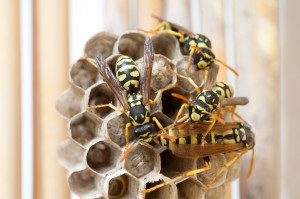You’re out doing a little yard work when, out of the blue, you are attacked by a swarm of yellowjacket wasps. You didn’t know it, but you inadvertently disturbed an underground yellowjacket nest. Ouch!
 With the Sacramento summer well underway we are also entering the height of wasp activity in and around our homes. Among the most aggressive of wasps are yellowjackets, as they defend their nests from potential intruders—you.
With the Sacramento summer well underway we are also entering the height of wasp activity in and around our homes. Among the most aggressive of wasps are yellowjackets, as they defend their nests from potential intruders—you.
The western yellowjacket, Vespula pensylvanica, is the species of wasp that nests underground. They are the turkey vulture of wasps, as they are primarily scavengers. You’ll most likely see them foraging for food around garbage cans, pet dishes, fruit fallen from a tree, and backyard barbeque grills. We’ve seen them feed on the carcasses of dead animals and rodents, which is why they are often referred to as “meat bees”—but they aren’t bees at all.
A favorite underground nesting place for western yellowjackets is rodent burrows. If you’ve had moles or gophers in your yard, they have left wonderful little tunnels where the yellowjackets can build their nests. Homeowners commonly find, or trip over, yellowjacket nests in shrubbery areas that don’t get enough water to flood the wasps out of their underground homes. But they’ll also seek out sites such as under concrete walkways or around the foundations of houses. Wasps will dig out dirt to expand their nests, so one tell-tale sign may be small piles of loose, dry soil around the nest entrance.
One way to help prevent yellowjackets from making their homes near yours is to be sure you properly dispose of trash and uneaten human and pet food—just as you would to prevent foraging raccoons, skunks or bears. Once the yellowjackets find out your cat or dog doesn’t eat all its dinner, they’ll keep coming back, searching for an easy meal and possibly a future nesting site.
While there are a few home-spun methods for tackling a yellowjacket infestation, simply spraying the nest with a can of bug spray is not recommended. The problem with spraying pesticides from a can is you don’t know how many wasps are in the nest. There could be a thousand yellowjackets all emerging at once you start spraying the pesticide. If you don’t get them all or your spray can runs dry, you’d better hope you can out run an angry flying yellowjacket. Although a single yellowjacket sting is rarely fatal, those with allergies may suffer anaphylactic shock, and multiple wasp stings can result in serious, even life-threatening injury, as happened in the recent case of a Canadian mayor killed by wasps.
Don’t risk painful stings. Inspection, identification of nests and safe eradication of yellow jackets and other wasps is all part of our professional pest control service. Plus, we can also run really fast if we have to. But we’ve never had to outrun a yellowjacket, and we’ll make sure you don’t have to either.


